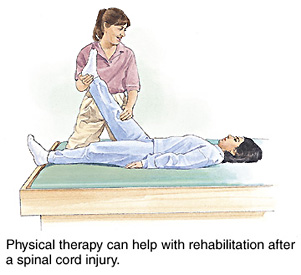Did you know that Spinal Injuries are not Reversible?
- rubiyatrumel123
- Dec 3, 2020
- 4 min read
This week topic will cover everything you need to know about spinal injuries.
What is a Spinal Injury?
A spinal cord injury (SCI) is a damage to any part of the spinal cord or nerves at the end of the spinal canal (cauda equina) where often causes permanent changes in strength, sensation and other body functions below the site of the injury.
It’s an extremely serious type of physical trauma that’s likely to have a lasting and significant impact on most aspects of daily life.
Spinal cord injuries tend to affect more men than women, and the majority of people who sustain a spinal cord injury are between the ages of 16 and 30 due to the increased likelihood of risky behaviours.
Here is an anatomy of the Spinal Cord:
Signs and Symptoms
The symptoms of a spinal cord injury vary from person to person. The lowest normal part of your spinal cord is referred to as the neurological level of your injury.
The severity of the injury is often called the completeness and is classified as either of the following:
Complete.
Incomplete.
Paralysis from a spinal cord injury may be referred to as:
Tetraplegia
Paraplegia
Spinal cord injuries of any kind may result in one or more of the following signs and symptoms:
Loss of movement
Loss or altered sensation, including the ability to feel heat, cold and touch
Loss of bowel or bladder control
Exaggerated reflex activities or spasms
Changes in sexual function, sexual sensitivity and fertility
Pain or an intense stinging sensation caused by damage to the nerve fibers in your spinal cord
Difficulty breathing, coughing or clearing secretions from your lungs
Having these symptoms does not necessarily mean that a person has a spinal cord injury. Sometimes, a broken backbone can put pressure on the spinal cord, causing symptoms that may go away after the bone heals.
However, the serious nature of spinal cord injuries means that it is always important to seek emergency medical care if these symptoms appear. Anyone who is with a person who may have sustained a back injury should avoid trying to lift or move them, as this could significantly worsen any damage.
🚨Emergency signs and symptoms
Emergency signs and symptoms of a spinal cord injury after an accident may include:
Extreme back pain or pressure in your neck, head or back
Weakness, incoordination or paralysis in any part of your body
Numbness, tingling or loss of sensation in your hands, fingers, feet or toes
Loss of bladder or bowel control
Difficulty with balance and walking
Impaired breathing after injury
An oddly positioned or twisted neck or back
Causes
Spinal cord injuries are most often the result of vehicle accidents. Followed closely by falls. Other causes include acts of violence (primarily gunshot wounds) and sports-related injuries.
Non-traumatic causes of spinal cord injury may include cancer and osteoporosis, spinal tumors, multiple sclerosis, inflammation of the spinal cord, arthritis, spinal stenosis and blood loss.
Risk Factors
Although a spinal cord injury is usually the result of an accident and can happen to anyone, certain factors may predispose you to a higher risk of sustaining a spinal cord injury, including:
Being male.
Being between the ages of 16 and 30.
Being older than 65.
Engaging in risky behaviour.
Having a bone or joint disorder.
Treatments/Recovery
Unfortunately, there's no way to reverse damage to the spinal cord. But researchers are continually working on new treatments, including prostheses and medications that may promote nerve cell regeneration or improve the function of the nerves that remain after a spinal cord injury.
Early (acute) stages of treatment:
Maintaining your ability to breathe
Preventing shock
Immobilizing your neck to prevent further spinal cord damage
Avoiding possible complications, such as stool or urine retention, respiratory or cardiovascular difficulty, and formation of deep vein blood clots in the extremities
If you do have a spinal cord injury, you'll usually be admitted to the intensive care unit for treatment. You may even be transferred to a regional spine injury center that has a team of neurosurgeons, orthopedic surgeons, spinal cord medicine specialists, psychologists, nurses, therapists and social workers with expertise in spinal cord injury.
After stages of treatments:
Medications.
Immobilization.
Surgery.
Experimental treatments.
Rehabilitation.
Preventions
This list may reduce your risk of a spinal cord injury:
Drive safely.
Check water depth before diving.
Prevent falls.
Take precautions when playing sports.
Don't drink and drive.
First Aid Tips!
If you suspect a back or neck (spinal) injury, do not move the affected person. Permanent paralysis and other serious complications can happen.
Assume a person has a spinal injury if:
There's evidence of a head injury with an ongoing change in the person's level of consciousness.
The person complains of severe pain in his or her neck or back.
An injury has exerted substantial force on the back or head.
The person complains of weakness, numbness, or paralysis or lacks control of his or her limbs, bladder or bowels.
The neck or body is twisted or positioned oddly.
If you do suspect someone has a spinal injury:
Don't move the injured person (permanent paralysis and other serious complications may result).
Call 911 or your local emergency medical assistance number.
Keep the person still.
Place heavy towels on both sides of the neck or hold the head and neck to prevent them from moving until emergency care arrives.
Provide basic first aid, such as stopping any bleeding and making the person comfortable, without moving the head or neck.
Here is an excellent video explaining the procedures demonstrated by Gemma Bignall:
Hope that was a good read and you learned something new!
We are approaching the finals week!!! Good luck to everyone!
References
mayoclinic.org
shepherd.org
medicalnewstoday.com



.png)















Comments